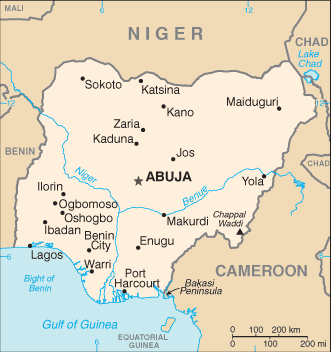Map:

Overview:
Following nearly 16 years of military rule, a new constitution was adopted in 1999, and a peaceful transition to civilian government was completed. The president faces the daunting task of rebuilding a petroleum-based economy, whose revenues have been squandered through corruption and mismanagement, and institutionalizing democracy. In addition, the OBASANJO administration must defuse longstanding ethnic and religious tensions, if it is to build a sound foundation for economic growth and political stability. Despite some irregularities, the April 2003 elections marked the first civilian transfer of power in Nigeria's history.
The People:
Population: 128,771,988
note: estimates for this country explicitly take into account the effects of excess mortality due to AIDS; this can result in lower life expectancy, higher infant mortality and death rates, lower population and growth rates, and changes in the distribution of population by age and sex than would otherwise be expected (July 2005 est.)
Age structure:
0-14 years: 42.3% (male 27,466,766/female 27,045,092)
15-64 years: 54.6% (male 35,770,593/female 34,559,414)
65 years and over: 3.1% (male 1,874,157/female 2,055,966) (2005 est.)
Religions:
Muslim 50%, Christian 40%, indigenous beliefs 10%
Government Type:
federal republic
Leader(s) to pray for:
chief of state: President Olusegun OBASANJO (since 29 May 1999); note - the president is both the chief of state and head of government
Source: The World Factbook
View All Countries